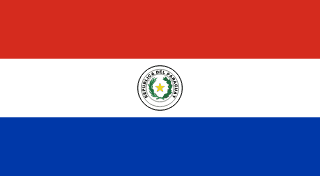Paraguay - Geography

Here, let us take a look at the Geography of Paraguay. Landlocked; lies between Argentina, Bolivia, and Brazil; population concentrated in eastern and southern part of country. Mother's mean age at first birth is 22.9 years (2008 est.) (Note: data represents median age at first birth among women 25-29), whereas, the Maternal mortality ratio is 58 deaths/100,000 live births (2023 est.)
Geographical data of Paraguay
| Location | Central South America, northeast of Argentina, southwest of Brazil |
|---|---|
| Geographic coordinates | 23 00 S, 58 00 W |
| Map references | South America |
| Tarrain | grassy plains and wooded hills east of Rio Paraguay; Gran Chaco region west of Rio Paraguay mostly low, marshy plain near the river, and dry forest and thorny scrub elsewhere |
| Natural Resources | hydropower, timber, iron ore, manganese, limestone |
| Natural Hazards | local flooding in southeast (early September to June); poorly drained plains may become boggy (early October to June) |
| Irrigated Land | 1,362 sq km (2012) |
| Major rivers (by length in km) | Río de la Plata/Paraná (shared with Brazil [s], Argentina, and Uruguay [m]) - 4,880 km; Paraguay river mouth (shared with Brazil [s] and Argentina) - 2,549 km note: [s] after country name indicates river source; [m] after country name indicates river mouth |
| Major aquifers | Guarani Aquifer System |
| Land Boundaries | 4,655 km |
| Border Countries | Argentina 2,531 km; Bolivia 753 km; Brazil 1,371 km |
| Coastline | 0 km (landlocked) |
| Climate | subtropical to temperate; substantial rainfall in the eastern portions, becoming semiarid in the far west |
| Area | |
| Total Area | |
| Land Area | 397,302 sq km |
| Water Area | 9,450 sq km |
| comparative Area | about three times the size of New York State; slightly smaller than California |
| Maritime Claims | |
| Elevations | |
| Highest point | Cerro Pero 842 m |
| Lowest point | junction of Río Paraguay and Río Paraná 46 m |
| Mean elevation | 178 m |
| Land Use | |
| Agricultural land | 54.1% (2023 est.) |
| Agricultural land: arable land | arable land: 11.5% (2023 est.) |
| Agricultural land: permanent crops | permanent crops: 0.2% (2023 est.) |
| Agricultural land: permanent pasture | permanent pasture: 42.4% (2023 est.) |
| Forest | 36.9% (2023 est.) |
| Other | 7% (2023 est.) |
Population Distribution
Most of the population resides in the eastern half of the country; to the west lies the Gran Chaco (a semi-arid lowland plain), which accounts for 60% of the land territory, but only 2% of the overall population
People and Society
In Paraguay, the different Ethnic groups are such that we have: Mestizo (mixed Spanish and Indigenous ancestry) 95%, other 5%
| Population | |
|---|---|
| Pop growth rate | 1.09% (2024 est.) |
| Birth rate | 15.9 births/1,000 population (2024 est.) |
| Death rate | 4.9 deaths/1,000 population (2024 est.) |
| Health expenditure | |
| Physicians Density | |
| Hospital bed Density | 1 beds/1,000 population (2020 est.) |
| Total fertility rate | 1.88 children born/woman (2024 est.) |
| Gross reproduction rate | 0.92 (2024 est.) |
| Contraceptive prevalence rate | |
| Est married women (ages 15-49) | 59.4% (2023 est.) |
| Literacy | |
| Education expenditures | |
| Net Migration rate | -0.1 migrant(s)/1,000 population (2024 est.) |
| Nationality | Paraguayan | Paraguayan(s) |
| Languages | |
| Religions | Roman Catholic 80.4%, Protestant 7% (Evangelical (non-specific) 6.7%, Evangelical Pentecostal <0.1%, Adventist <0.1%, Protestant (non-specific) <0.1%), Believer (not belonging to the church) 5.7%, other 0.6%, agnostic <0.1%, none 0.2%, unspecified 6.2% (2023 est.) |
| Age Structure | |
| 0-14 years | 22.2% (male 850,191/female 821,237) |
| 15-64 years | 68.4% (male 2,582,021/female 2,561,962) |
| 65 years and over | 9.4% (2024 est.) (male 337,164/female 369,974) |
| Dependency Ratios | |
| Total dependency ratio | 46.2 (2024 est.) |
| Youth dependency ratio | 32.5 (2024 est.) |
| Elderly dependency ratio | 13.7 (2024 est.) |
| Potential support ratio | 7.3 (2024 est.) |
| Median Age | |
| Total | 31.8 years (2024 est.) |
| Male | 31.6 years |
| Female | 32 years |
| Urbanization | |
| Urban population | 63.1% of total population (2023) |
| Rate of urbanization | 1.64% annual rate of change (2020-25 est.) |
| Major urban areas (Pop) | 3.511 million ASUNCION (capital) (2023). |
| Sex Ratio | |
| At birth | 1.05 male(s)/female |
| 0-14 years | 1.04 male(s)/female |
| 15-64 years | 1.01 male(s)/female |
| 65 years and over | 0.91 male(s)/female |
| Total population | 1 male(s)/female (2024 est.) |
| Infant Motality | |
| Total | 22 deaths/1,000 live births (2024 est.) |
| Male | 26.1 deaths/1,000 live births |
| Female | 17.7 deaths/1,000 live births |
| Life Expectancy at birth | |
| Total population | 78.8 years (2024 est.) |
| Male | 76.2 years |
| Female | 81.6 years |
| Drinking Water Sources | |
| Improved: urban | urban: 99.9% of population (2022 est.) |
| Improved: rural | rural: 99.1% of population (2022 est.) |
| Improved: total | total: 99.6% of population (2022 est.) |
| Unimproved: urban | urban: 0.1% of population (2022 est.) |
| Unimproved: rural | rural: 0.9% of population (2022 est.) |
| Unimproved: total | total: 0.4% of population (2022 est.) |
| Sanitation facility acess | |
| Improved: urban | urban: 100% of population (2022 est.) |
| Improved: rural | rural: 94.9% of population (2022 est.) |
| Improved: total | total: 98.1% of population (2022 est.) |
| Unimproved: urban | urban: 0% of population (2022 est.) |
| Unimproved: rural | rural: 5.1% of population (2022 est.) |
| Unimproved: total | total: 1.9% of population (2022 est.) |
| Alcohol consumption per capita | |
| Total | 5.47 liters of pure alcohol (2019 est.) |
| Beer | 3.27 liters of pure alcohol (2019 est.) |
| Wine | 0.59 liters of pure alcohol (2019 est.) |
| Spirits | 1.59 liters of pure alcohol (2019 est.) |
| Other alcohols | 0.03 liters of pure alcohol (2019 est.) |
| Tobacco use | |
| Total | 9.3% (2025 est.) |
| Male | 15.5% (2025 est.) |
| Female | 3.3% (2025 est.) |
| Child marriage | |
| Women married by age 15 | 3.6% (2016) |
| Women married by age 18 | 21.6% (2016) |
Demographic profile
All Important Facts about Paraguay
Want to know more about Paraguay? Check all different factbooks for Paraguay below.









